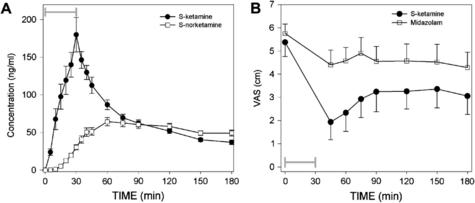Pain Management
Chronic Pain Management
Absence of long-term analgesic effect from a short-term S-ketamine infusion on fibromyalgia pain: A randomized, prospective, double blind, active placebo-controlled trial
Noppers I, Niesters M, Swartjes M, et al (Leiden Univ Med Ctr, The Netherlands) Eur J Pain 15:942-949, 2011§
Evidence Ranking
• A
Expert Rating
• 2
Abstract
To assess the analgesic efficacy of the N-methyl-d-aspartate receptor antagonist S(+)-ketamine on fibromyalgia pain, the authors performed a randomized double blind, active placebo-controlled trial. Twenty-four fibromyalgia patients were randomized to receive a 30-min intravenous infusion with S(+)-ketamine (total dose 0.5 mg/kg, n = 12) or the active placebo, midazolam (5 mg, n = 12). Visual Analogue Pain Scores (VAS) and ketamine plasma samples were obtained for 2.5-h following termination of treatment; pain scores derived from the fibromyalgia impact questionnaire (FIQ) were collected weekly during an 8-week follow-up. Fifteen min after termination of infusion the number of patients showing a reduction in pain scores >50% was 8 vs. 3 (P < 0.05), at t = 180 min 6 vs. 2 (ns), at the end of week-1 2 vs. 0 (ns) and at end of week-8 2 vs. 2 in the ketamine and midazolam groups, respectively. Ketamine effect on VAS closely followed ketamine plasma concentrations. For VAS and FIQ scores no significant differences in treatment effects were observed in the 2.5-h following infusion or during the 8-week follow-up. Side effects as measured by the Bowdle questionnaire (which scores for 13 separate psychedelic symptoms) were mild to moderate in both study groups and declined rapidly, indicating adequate blinding of treatments. Efficacy of ketamine was limited and restricted in duration to its pharmacokinetics. The authors argue that a short-term infusion of ketamine is insufficient to induce long-term analgesic effects in fibromyalgia patients (Figs 2–4).

Full access? Get Clinical Tree




